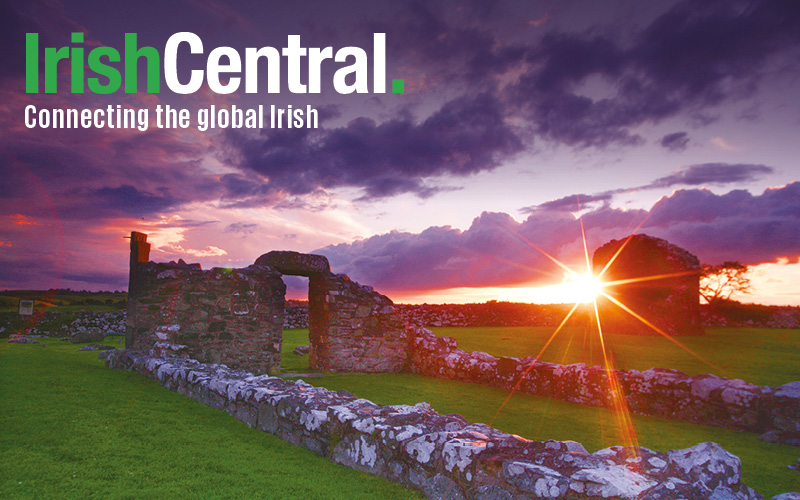The horror of Ireland’s famine was a “blight” but created an unbreakable bond between the countries and its people.
One cannot travel around the most beautiful Emerald Isle without constantly being reminded about “The Great Famine”, also commonly referred to as “The Potato Famine” or the “Great Hunger”. The tragic story of “The Great Famine” is told by numerous famine and emigration museums, restored workhouses, mass graveyards, cast iron famine pots, sculptures depicting starvation, historic homesteads of Irish emigrants, the Emigrant Flame, and replicas of “Coffin Ships”.
Kate was raised in North Albany in New York State. “Little Limerick” is still North Albany’s nickname, and without doubt, the number one holiday in Kate’s household was St. Patrick’s Day! Kate quickly adapts to the Irish brogue when traveling in Ireland, and as for Mike, he often needs an interpretation of Kate’s conversations with our B&B hosts and hostesses. Kate has often been mistaken to be a native “Irish lass”!
As for Mike, he was born and raised in Lewis County in New York State on the western fringe of the Adirondack Mountains. The rocky, fertile farmland attracted many Irish emigrant farmers looking for a new place to establish “roots” in America. The 1850 U.S. Census for Lewis County and surrounding counties is a literal log of Irish surnames.
Kate’s Irish immigrant ancestors included: Brynes, McGuirks, and McDermotts from County Wicklow; Regans, Walshes, and Harneys from County Waterford; and Fitzpatricks and Waters from County Tipperary.
As for Mike, his Irish immigrant ancestors included: Kennedys, Doyles, and Whelans from Wexford Co.; Laides and Sullivans from Kerry Co.; and Fishers and his Rooneys from parts unknown.
The “Potato Blight” struck in 1845 following a period of time when extreme poverty had already become widespread in Ireland. Within five years, more than one million Irish died and in the next decade, 1.5 million adults and children left Ireland to seek refuge in America. The “flood” of Irish immigrants to America were mostly poor peasants and many suffered from starvation and/or disease.

Gravestones of several of President John F. Kennedy’s ancestors can be seen in the Whitechurch Cemetery, south of Dunganstown, Co. Wexford.
Unfortunately, life in America continued to be a struggle for many Irish immigrants who had fled poverty and disease. Most who stayed in cities lived in slum tenements and faced religious prejudice as most of them were Catholic. Many unskilled laborers already in America feared being put out of work by Irish immigrants willing to work for less. The press described Irish as “aliens” and newspaper advertisements for jobs and housing routinely ended with the statement, “No Irish Need Apply”.

An newspaper illustration from the time. A shop front displays a "No Irish Need Apply" sign.
America provided Irish immigrants with opportunity, while the Irish brought with them their talents, resilience, grit, and determination to be successful and begin a new life in a foreign land. Like so many waves of immigrants from other lands, the Irish arrived in the U.S. with few if any material possessions. What they did bring with them was a renewed enthusiasm for the “American Dream.”

Costumed performers serve as guides aboard the Dunbrody Famine Ship in New Ross, Co. Wexford
If the term “sanctuary city or state” had been around in the 1840s and 1850s, then Boston, New York City, and Albany, NY would all have been “sanctuary cities” for the Irish. These cities, as well as many other cities and states, welcomed the Irish and provided them with freedom of religion, job and housing opportunities, and political footing in America’s land of diversity.
On October 28, 1886, the Statue of Liberty in New York Harbor was dedicated and has long been recognized as a universal symbol of freedom and democracy. The Statue of Liberty was a gift from France but stands as a welcoming symbol for any and all emigrants who enter the United States.

The Dunbrody Famine Ship in New Ross, Co. Wexford is an authentic full scale reproduction of an 1840s emigrant ship.
“The New Colossus” poem is mounted on a plaque inside the pedestal of the Statue of Liberty. It reads, “Give me your tired, your poor, your huddled masses yearning to breathe free, the wretched refuse of your teeming shore. Send these, the homeless, tempest-tossed to me, I lift my lamp beside the golden door!”

The Statue of Liberty: “Give me your tired, your poor, your huddled masses yearning to breathe free."
Although the Statue of Liberty did not grace the entrance to New York Harbor during the years of the Great Famine, one can easily imagine that when Emma Lazarus wrote “The New Colussus” she was referring to those who fled the Irish Potato Blight, as well as the many millions of other “huddled masses” and “wretched refuse” who left the “teeming shores” of their homelands to “breathe free”.
An estimated 4.5 million Irish emigrated to America between 1820 and 1930. By 1930, the Irish had spread into all spheres of American life including politics. In 1960, John F. Kennedy, the great-grandson of famine emigrant Patrick Kennedy, was elected president of the United States. Within three generations, the great-grandson of one of Ireland’s “tired, poor and homeless” immigrants was elected U.S. President!

The Kennedy Homestead in Dunganstown, Co. Wexford: the ancestral home of U.S. President John F. Kennedy’s great grandfather who emigrated in 1849.
The Great Famine was indeed a “blight” on Ireland’s history. On the other hand, as descendants of Irish immigrants, we strongly believe that the flood of Irish emigrants to America during and after the famine created a lasting bond between Ireland and the United States. We are very proud of our Irish American ancestors, and as we travel around Ireland’s countryside, we never tire of sharing our heritage with the always friendly and helpful people of Ireland.
* Kate and Mike Lancor live in Moultonborough, NH, U.S. and have traveled to Ireland numerous times. They can be reached on their website www.oldfriendsgenealogy.com or by emailing [email protected]. You can also visit their Old Friends Genealogy Facebook page.
* Originally published in April 2017.
This article was submitted to the IrishCentral contributors network by a member of the global Irish community. To become an IrishCentral contributor click here.




Comments